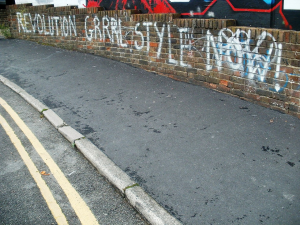6.1 Chapter Overview and Learning Objectives
6.1.1 Learning Objectives
- Outline how the social sciences and humanities approach the study of culture.
- Compare and contrast ethnocentrism and cultural relativism.
- Identify the different elements of a culture.
- Explain material versus nonmaterial culture, declarative versus nondeclarative culture.
- Explain the significance of symbols and language to a culture.
- Differentiate values and norms.
- Compare a subculture to dominant culture.
- Discuss the roles of both high culture and pop culture within society.
- Explain how cultural capital, boundary drawing, othering, and taste patterns can create inequalities.

In the late 1980s and early 1990s a movement within punk rock, called riot grrrl, emerged from Olympia, Washington and Washington D.C. The riot part of the name, emphasizing the challenge to a society that continually devalues women. The grrrl part of the name making a connection to childhood (girl) and sounding like an angry growl (Schilt 2003). Drawing inspiration from feminism, the movement addressed issues related to abuse, sexuality, patriarchy, rape, and racism. They did so through music, but also magazines (zines) and additional forms of media. One of the most well known groups to emerge from the movement was Bikini Kill, fronted by Kathleen Hanna. Their song “Rebel Girl” struck at some of the core themes of the movement.
In the riot grrrl manifesto authored by Hanna (2011) for the Bikini Kill zine, she outlined some of the values of the movement:
BECAUSE we are interested in creating non-hierarchical ways of being AND making music, friends, and scenes based on communication + understanding, instead of competition + good/bad categorizations.
BECAUSE doing/reading/seeing/hearing cool things that validate and challenge us can help us gain the strength and sense of community that we need in order to figure out how bullshit like racism, able-bodieism, ageism, speciesism, classism, thinism, sexism, anti-semitism and heterosexism figures in our own lives.
BECAUSE we see fostering and supporting girl scenes and girl artists of all kinds as integral to this process.
BECAUSE we are angry at a society that tells us Girl = Dumb, Girl = Bad, Girl = Weak”
Yet most people in the United States probably remain unfamiliar with the movement. The mainstream media of the day did cover the movement, but a lot of the coverage was negative claiming the movement was immature and ridiculous (Schilt 2003). Reflecting on her experiences, Hanna noted (Burbank 2015) “[Bikini Kill was] very vilified during the ’90s by so many people, and hated by so many people, and I think that that’s been kind of written out of the history,” she says. “People were throwing chains at our heads—people hated us—and it was really, really hard to be in that band.”
How can we use our sociological imagination to help us understand riot grrrl? What does the movement and public reaction to it say about American culture? Reflecting on equity and diversity, whose voices were included and excluded in the movement? What role does culture play in those processes of inclusion and exclusion? In what follows we will explore how sociologists understand culture, while developing some of the conceptual tools to answer these questions.
